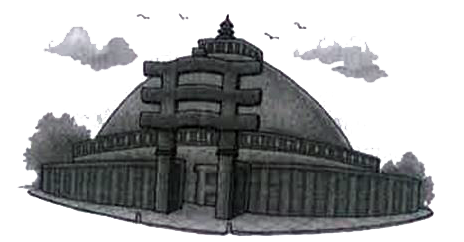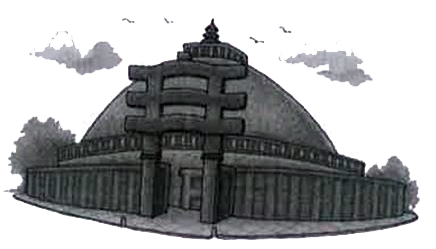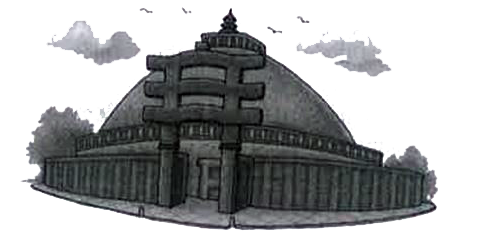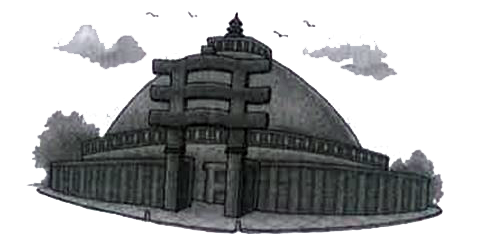One of the prominent Buddhist structures in India, ………. Stupa at Sarnath was constructed by the great Mauryan king. Ashoka.
Dhauli
Dhamekh
Bharhut
Lalitgiri
The correct Answer is:B
One of the prominent Buddist structures in India, Damekh Stupa at Sarnath was constructed by the great Mauryan king, Ashoka. Dhamek Stupa is the Sanskrit version fo Dharmarajika Stupa. According to the Buddhist literature, this stupa was built on the spot where the Buddha gave the first sermon to his first five Brahmin disciples after attaining enlightenment, "revealing his Eightfold Path leading to nirvana".
Topper's Solved these Questions
- HISTORYBOOK - PINNACLECHAPTER - HISTORYEXERCISE - MAHAJANAPADAS
24 Videos
- HISTORYBOOK - PINNACLECHAPTER - HISTORYEXERCISE - MAURYAN EMPIRE
8 Videos
- HISTORYBOOK - PINNACLECHAPTER - HISTORYEXERCISE - JAINISM
4 Videos
- GEOGRAPHYBOOK - PINNACLECHAPTER - GEOGRAPHYEXERCISE - WORLD GEOGRAPHY AND MAP
3 Videos
- PHYSICS BOOK - PINNACLECHAPTER - PHYSICS EXERCISE - UNITS AND MEASCUREMENT
57 Videos
Similar Questions
Following is a narrative on Sanchi stupa. Listen to it carefully and answer the questions that follow. You can listen to the recorded narrative or ask your teacher, sibling or friend to read it aloud.
The fascinating and world famous Sanchi stupa is located on a hilltop in Sanchi town, Madhya Pradesh, India. It is one of the most important Buddhist monuments that portrays Buddhist art and sculpture. Starting from the third century BC through the twelfth century AD, it attracts the attention of thousands of visitors round the year including national and foreign tourists, archaeologists, and historians among others. This stupa is the oldest stone structure in India that was built during the Mauryan period. Originally commissioned in the third century BCE by Emperor Ashoka, this huge hemispherical dome consists of a central chamber. In this chamber, the relics of Lord Buddha are placed. The original construction work of this stupa was supervised by Ashoka. His wife, Devi, was the daughter of a merchant of nearby village. Vidisha. Sanchi was also her birthplace as well as the venue of her and Ashoka's wedding. Later, four omamental gateways or toranas facing four directions and a balustrade surrounding the stupa were added in the first century BCE. The Great stupa at Sanchi is one of the oldest stone structures in India and counted among the best conserved ancient stupas of Central India. It has been enlisted as an UNESCO World Heritage Site since 1989.
The sculptures on the ornamental gateways or toranas consist of decorative illustrations of events encompassing the life of Lord Buddha. These events are explained in the Jataka tales. The tree used here symbolises Lord Buddha. The most striking features regarding the stupa is that Lord Buddha has been depicted symbolically by figures like thrones, wheels, and footprints among others.
Which Buddhist monument is referred to here and what does it portray?

View SolutionFollowing is a narrative on Sanchi stupa. Listen to it carefully and answer the questions that follow. You can listen to the recorded narrative or ask your teacher, sibling or friend to read it aloud.
The fascinating and world famous Sanchi stupa is located on a hilltop in Sanchi town, Madhya Pradesh, India. It is one of the most important Buddhist monuments that portrays Buddhist art and sculpture. Starting from the third century BC through the twelfth century AD, it attracts the attention of thousands of visitors round the year including national and foreign tourists, archaeologists, and historians among others. This stupa is the oldest stone structure in India that was built during the Mauryan period. Originally commissioned in the third century BCE by Emperor Ashoka, this huge hemispherical dome consists of a central chamber. In this chamber, the relics of Lord Buddha are placed. The original construction work of this stupa was supervised by Ashoka. His wife, Devi, was the daughter of a merchant of nearby village. Vidisha. Sanchi was also her birthplace as well as the venue of her and Ashoka's wedding. Later, four omamental gateways or toranas facing four directions and a balustrade surrounding the stupa were added in the first century BCE. The Great stupa at Sanchi is one of the oldest stone structures in India and counted among the best conserved ancient stupas of Central India. It has been enlisted as an UNESCO World Heritage Site since 1989.
The sculptures on the ornamental gateways or toranas consist of decorative illustrations of events encompassing the life of Lord Buddha. These events are explained in the Jataka tales. The tree used here symbolises Lord Buddha. The most striking features regarding the stupa is that Lord Buddha has been depicted symbolically by figures like thrones, wheels, and footprints among others.
Who are the people who visit this Stupa throughout the year?

View Solution
Knowledge Check
One of the prominent Buddhist structures in India, --------------- stups at Sarnath was constructed by the great Mauryan king, Ashoka.
ADhauliBDhamekhCBharhutDLalitgiriOne of the prominent Buddhist structures in India, --------------- stups great Mauryan king, Ashoka.
ADhauliBDhamekhCBharhutDLalitgiriIndia was a prosperous country……………….the reign of king Ashoka
AbetweenBfromCduringDwhile
Following is a narrative on Sanchi stupa. Listen to it carefully and answer the questions that follow. You can listen to the recorded narrative or ask your teacher, sibling or friend to read it aloud.
The fascinating and world famous Sanchi stupa is located on a hilltop in Sanchi town, Madhya Pradesh, India. It is one of the most important Buddhist monuments that portrays Buddhist art and sculpture. Starting from the third century BC through the twelfth century AD, it attracts the attention of thousands of visitors round the year including national and foreign tourists, archaeologists, and historians among others. This stupa is the oldest stone structure in India that was built during the Mauryan period. Originally commissioned in the third century BCE by Emperor Ashoka, this huge hemispherical dome consists of a central chamber. In this chamber, the relics of Lord Buddha are placed. The original construction work of this stupa was supervised by Ashoka. His wife, Devi, was the daughter of a merchant of nearby village. Vidisha. Sanchi was also her birthplace as well as the venue of her and Ashoka's wedding. Later, four omamental gateways or toranas facing four directions and a balustrade surrounding the stupa were added in the first century BCE. The Great stupa at Sanchi is one of the oldest stone structures in India and counted among the best conserved ancient stupas of Central India. It has been enlisted as an UNESCO World Heritage Site since 1989.
The sculptures on the ornamental gateways or toranas consist of decorative illustrations of events encompassing the life of Lord Buddha. These events are explained in the Jataka tales. The tree used here symbolises Lord Buddha. The most striking features regarding the stupa is that Lord Buddha has been depicted symbolically by figures like thrones, wheels, and footprints among others.
In which period the Stupa was built, and who commissioned it?

View SolutionFollowing is a narrative on Sanchi stupa. Listen to it carefully and answer the questions that follow. You can listen to the recorded narrative or ask your teacher, sibling or friend to read it aloud.
The fascinating and world famous Sanchi stupa is located on a hilltop in Sanchi town, Madhya Pradesh, India. It is one of the most important Buddhist monuments that portrays Buddhist art and sculpture. Starting from the third century BC through the twelfth century AD, it attracts the attention of thousands of visitors round the year including national and foreign tourists, archaeologists, and historians among others. This stupa is the oldest stone structure in India that was built during the Mauryan period. Originally commissioned in the third century BCE by Emperor Ashoka, this huge hemispherical dome consists of a central chamber. In this chamber, the relics of Lord Buddha are placed. The original construction work of this stupa was supervised by Ashoka. His wife, Devi, was the daughter of a merchant of nearby village. Vidisha. Sanchi was also her birthplace as well as the venue of her and Ashoka's wedding. Later, four omamental gateways or toranas facing four directions and a balustrade surrounding the stupa were added in the first century BCE. The Great stupa at Sanchi is one of the oldest stone structures in India and counted among the best conserved ancient stupas of Central India. It has been enlisted as an UNESCO World Heritage Site since 1989.
The sculptures on the ornamental gateways or toranas consist of decorative illustrations of events encompassing the life of Lord Buddha. These events are explained in the Jataka tales. The tree used here symbolises Lord Buddha. The most striking features regarding the stupa is that Lord Buddha has been depicted symbolically by figures like thrones, wheels, and footprints among others.
Where is the central chamber in the Stupa? What is kept inside it?

View SolutionFollowing is a narrative on Sanchi stupa. Listen to it carefully and answer the questions that follow. You can listen to the recorded narrative or ask your teacher, sibling or friend to read it aloud.
The fascinating and world famous Sanchi stupa is located on a hilltop in Sanchi town, Madhya Pradesh, India. It is one of the most important Buddhist monuments that portrays Buddhist art and sculpture. Starting from the third century BC through the twelfth century AD, it attracts the attention of thousands of visitors round the year including national and foreign tourists, archaeologists, and historians among others. This stupa is the oldest stone structure in India that was built during the Mauryan period. Originally commissioned in the third century BCE by Emperor Ashoka, this huge hemispherical dome consists of a central chamber. In this chamber, the relics of Lord Buddha are placed. The original construction work of this stupa was supervised by Ashoka. His wife, Devi, was the daughter of a merchant of nearby village. Vidisha. Sanchi was also her birthplace as well as the venue of her and Ashoka's wedding. Later, four omamental gateways or toranas facing four directions and a balustrade surrounding the stupa were added in the first century BCE. The Great stupa at Sanchi is one of the oldest stone structures in India and counted among the best conserved ancient stupas of Central India. It has been enlisted as an UNESCO World Heritage Site since 1989.
The sculptures on the ornamental gateways or toranas consist of decorative illustrations of events encompassing the life of Lord Buddha. These events are explained in the Jataka tales. The tree used here symbolises Lord Buddha. The most striking features regarding the stupa is that Lord Buddha has been depicted symbolically by figures like thrones, wheels, and footprints among others.
What structures were added to the huge hemisphere in first century BCE?

View SolutionFollowing is a narrative on Sanchi stupa. Listen to it carefully and answer the questions that follow. You can listen to the recorded narrative or ask your teacher, sibling or friend to read it aloud.
The fascinating and world famous Sanchi stupa is located on a hilltop in Sanchi town, Madhya Pradesh, India. It is one of the most important Buddhist monuments that portrays Buddhist art and sculpture. Starting from the third century BC through the twelfth century AD, it attracts the attention of thousands of visitors round the year including national and foreign tourists, archaeologists, and historians among others. This stupa is the oldest stone structure in India that was built during the Mauryan period. Originally commissioned in the third century BCE by Emperor Ashoka, this huge hemispherical dome consists of a central chamber. In this chamber, the relics of Lord Buddha are placed. The original construction work of this stupa was supervised by Ashoka. His wife, Devi, was the daughter of a merchant of nearby village. Vidisha. Sanchi was also her birthplace as well as the venue of her and Ashoka's wedding. Later, four omamental gateways or toranas facing four directions and a balustrade surrounding the stupa were added in the first century BCE. The Great stupa at Sanchi is one of the oldest stone structures in India and counted among the best conserved ancient stupas of Central India. It has been enlisted as an UNESCO World Heritage Site since 1989.
The sculptures on the ornamental gateways or toranas consist of decorative illustrations of events encompassing the life of Lord Buddha. These events are explained in the Jataka tales. The tree used here symbolises Lord Buddha. The most striking features regarding the stupa is that Lord Buddha has been depicted symbolically by figures like thrones, wheels, and footprints among others.
The toranas are decorated with: (Tick the right answer
(a) stone omaments
(b) events of Lord Buddha's life ( )
(c) Lord Buddha's relics ( )
(d)symbolic depiction of Lord Buddha as throne , wheel, footprints , etc. ( )

View SolutionIndia was a prosperous country……………….the reign of king Ashoka
View Solution
